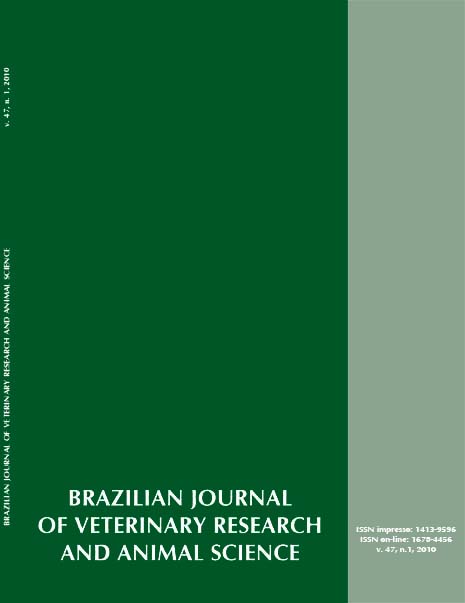Evaluation of used progestagen implants on pregnancy rate in beef cows
DOI:
https://doi.org/10.11606/issn.1678-4456.bjvras.2010.26847Keywords:
Estrous cycle, Estrous synchronization, Norgestomet, ReproductionAbstract
Two-hundred and twenty-one (78 suckling - 40 to 90 days and 143 not suckling ) Nelore (Bos taurus indicus) and crossbred Charolais (Bos taurus taurus) cows were used to evaluate the reutilization of progestagen implants to pharmacological control of the estrus cycle and ovulation on pregnancy rate. Cows were randomly assigned to one of three protocols for estrous synchronization and pre-fixed time artificial insemination (FTAI) was performed. In treatment 1 (T1; n = 73) cows were implanted with Crestar® (3 mg de norgestomet); in treatment 2 (T2; n = 75) cows were implanted with already used Crestar®, and in treatment 3 (T3; n = 73) cows received two Crestar® implants, also both previously used. All cows were injected with 2 mL of progesterone (25 mg/mL) + 1 mL estradiol benzoate (1 mg/mL i.m.) at the time of implants insertion, intramuscular (i.m). Implants were removed after eight days and 2 mL of Preloban® (150 µg de D-cloprostenol) were administered i.m. Twenty-four hours after implants removal, cows were injected with 1 mL (i.m.) of Estrogin® (1mg of estradiol benzoate). The FTAI was performed 54-56 h after implants removal. There was no difference (P >; 0.05) on cow's pregnancy rate among treatments. Pregnancy rates were 39.72, 34.21 and 36.98% for T1, T2 and T3, respectively. Progestagen implants reutilization (Crestar®) did not affected pregnancy rate in beef cows ready for reproduction.Downloads
Download data is not yet available.
Downloads
Published
2010-02-01
Issue
Section
UNDEFINIED
License
The journal content is authorized under the Creative Commons BY-NC-SA license (summary of the license: https://
How to Cite
1.
Maluf DZ, Pires AV, Susin I, Moreira RJ de C, Madureira EH, Binelli M, et al. Evaluation of used progestagen implants on pregnancy rate in beef cows. Braz. J. Vet. Res. Anim. Sci. [Internet]. 2010 Feb. 1 [cited 2026 Jan. 17];47(1):38-46. Available from: https://revistas.usp.br/bjvras/article/view/26847





